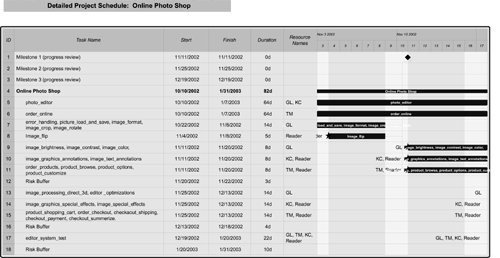The Detailed Project Schedule
As mentioned earlier, it is important to track the project and update the plan constantly. In this iteration we develop a more refined project schedule, as shown in Figure 5.7. The project schedule is kept in Microsoft Visio as a Gantt chart, showing the various tasks, their dependencies, and the project milestones. Online Photo Shop is the overall project, and we indent all other tasks to show that they are defined as subtasks.
Figure 5.7. Detailed Schedule

For easier readability, the requirements are grouped into blocks of related functionality. The name of the developer who is responsible for a block is shown in the resource column. Most of the blocks contain dependent or very small functionalities (or both). By combining these items into blocks, we make it easier to do tracking on a daily instead of an hourly basis.
In addition to the tasks themselves, including their estimated duration, other milestones are defined and connected to the related tasks (as indicated by the lines that go from the milestones to the tasks). The milestones are review points at which the status of the project is reviewed and necessary adjustments are made. In the case shown in Figure 5.7, the milestones coincide with the end (or the beginning) of the iterations. This works well if the requirements are broken into small enough pieces (no longer than two weeks' worth of effort). If you cannot do this, you must either break the tasks into smaller pieces or define interim milestones.
From the detailed schedule, you can see that even though the iterations are described in a serialized fashion, iterations are actually worked on in parallel. This practice shortens the overall duration of the project. In our case, working on development tasks in parallel works very well because the photo editor application and the online shop have no anticipated dependency. The schedule shown is constantly refined and updated throughout the development cycle. Also, we have added risk buffers to the schedule. These buffers give the project additional time to react to unforeseen problems. Nevertheless, the risk buffers should not be used for adding new requirements or implementing new features.
Tracking is done in small meetings. We hold one weekly meeting to discuss problems, ideas, and management-related items; in addition, stand-up meetings (which last about 12 minutes) are held every other day for frequent status updates (no discussions are allowed at these meetings). Stand-up meetings often lead to the calling of a regular meeting at another time so that team members can quickly discuss problems found.
From the Gantt chart we developed in Visio, we can export a variety of diagrams, such as a timeline diagram. These exported diagrams are very useful for reports to the customer or upper management (assuming that the plan is kept up-to-date).
Introducing .NET
- Introducing .NET
- The Need for .NET
- The .NET Framework
- The C# Language
- Debugging and the IDE
- References for Further Reading
Introducing Software Engineering
- Introducing Software Engineering
- Introducing Software Engineering Practices
- Choosing a Software Development Model
- Commonly Used Software Development Models
- Conclusion
- References for Further Reading
A .NET Prototype
- Getting Started
- Evaluating .NET for Windows Client Applications
- Our First .NET Application
- Prototyping
- Implementing the SmartNotes Application
- Visual Studio.NET: Platform of Choice
- References for Further Reading
Project Planning
- Project Planning
- The Project Vision and Business Case
- The Initial Use Case Model
- Project Requirements
- Initial Project Planning
- Initial Risk Analysis
- Initial Requirements Analysis and Design
- Conclusion
- References for Further Reading
The Photo Editor Application
- The Photo Editor Application
- The Refined Project Vision and Business Case
- Refined Requirements for Online Photo Shop
- Analysis of the Photo Editor Requirements
- Design of the Photo Editor Application
- The Detailed Project Schedule
- Implementation of the Photo Editor Application
- Unit Tests
- Conclusion
- References for Further Reading
GDI+ Graphics Extensions
- GDI+ Graphics Extensions
- Requirements for the GDI+ Extensions
- Analysis of the GDI+ Extensions Requirements
- Design of the GDI+ Extensions
- Project Management Issues
- GDI+ Programming
- Drawing GDI+ Primitives
- Unit Tests
- Conclusion
- References for Further Reading
Advanced GDI+ Operations
- Advanced GDI+ Operations
- Advanced GDI+ Extensions
- Analysis of the Advanced GDI+ Extensions Requirements
- Design of the Advanced GDI+ Extensions
- Project Management Issues
- Using Pens and Brushes in GDI+
- Implementation of Regions, Pens, and Brushes
- Unit Tests
- Conclusion
Dynamic Loading of Components
- Dynamic Loading of Components
- Requirements for Image Postprocessing Components
- Analysis of the Image Postprocessing Requirements
- Design of the Image-Processing Components Using Late Binding
- Project Management Issues
- Implementing Dynamically Loadable Image Postprocessing Plugins
- Unit Tests
- Conclusion
- References for Further Reading
Accessing System Resources
- Accessing System Resources
- Refining Requirements for 3D Text Display
- Three-Dimensional Rendering Technologies
- Analyzing User Interface Needs
- Using OpenGL.NET
- Adding 3D Text to the Photo Editor Application
- Conclusion: Dont Reinvent the Wheel
- References for Further Reading
Performance Optimization, Multithreading, and Profiling
- Performance Optimization, Multithreading, and Profiling
- Requirements for Performance Optimization
- Analysis of the Editor Optimization Requirement
- Design of the Optimizations
- Project Management Issues
- Multithreading and Optimization Implementation
- Unit Tests
- Conclusion
- References for Further Reading
Building the Web Application with ASP.NET
- Building the Web Application with ASP.NET
- Online Store Requirements
- Analyzing Interfaces and Activities
- Breakdown of the Code Modules
- Implementation of Online Photo Shop
- Conclusion
Security and Database Access
- Security and Database Access
- Secure Checkout
- Integrating Externally Supplied Software
- E-mail, Password, Credit Card: Creating a Customer Profile
- Secure Web Applications
- Database Access with ADO.NET
- Putting It All Together
- No Longer under Construction
- References for Further Reading
Product Release
EAN: 2147483647
Pages: 123
